Artificial Intelligence (AI), a computer program designed to simulate human cognitive processes, is an innovative and promising technology that seems ready to change our lives in countless ways, many of which (or most) we do not yet fully understand.
Military Applications of AI
With the rapid development of a technology that has the potential to provide enormous power, the outcomes can be unpredictable as it becomes widely available to the public, allowing users and researchers to explore new applications of AI in extensively deployed fields. Diverse industries such as education, healthcare, communication, and engineering have witnessed the impact of integrating AI into the workplace.
However, there is a principle of modern society that can be regarded as an undeniable maxim: any new technology that can be exploited and adjusted will be used for military purposes. The United States military is at the forefront of technological innovation, and this has always been the case, with AI already integrated into the Pentagon’s operations.
While simultaneously exploring how soldiers will best protect civilians, it must be acknowledged the potential dangers of AI when applied to lethal systems and devices. Having the support of machines to make tactical decisions is something we have experienced throughout the past century of mechanized warfare, but entrusting decisions regarding the use of lethal force to a computer program will remove some responsibility from humans and eliminate the ability to make nuanced, expressive, and ethical decisions about when to use force.
In chess, a player’s mistake can lead to a loss, which is merely a minor event. But in the military, a mistake can lead to death and destruction.
1. Autonomous Machine Guns

Two robot guns (black) are positioned atop a watchtower filled with surveillance cameras aimed at the Aroub refugee camp in the West Bank, taken on October 6, 2022. Israel has installed robotic weapons capable of firing tear gas, stun grenades, and rubber-tipped projectiles (to minimize harm) at Palestinian protesters. The robots, positioned above a crowded Palestinian refugee camp and in the nearby hotspot city of Hebron, use AI to monitor targets. (Photo: AP).
Deployed in Israel to cover the borders of the West Bank and Gaza Strip, these autonomous weapons are programmed to track and fire at targets independently, which can have devastating consequences for civilians. The idea of guns capable of firing at targets without precise and specific commands from humans is at least somewhat frightening or at the very least possible. And although it may sound like something out of a video game or a science fiction film about a future world, this exists and this technology has been implemented by the Israeli government.

Nearby the watchtower is the minaret of a major synagogue in the area. (Photo: AP).
However, it should be acknowledged that saying these weapons would fire without human intervention is an exaggeration, but it is not far from the truth. In the West Bank, Israeli settlements are intertwined, effectively enclosing “Palestinian territory” more than most Westerners can imagine. The map of the West Bank resembles a spider web of protected residential areas with the Israel Defense Forces (IDF) established in belts and checkpoints, ostensibly to maintain peace. In the control towers, soldiers monitor activities outside the wall to detect potential threats, and when a target is identified, the soldier can order the gun towers to engage the specified target—and the guns will take over from there. The guns are said to be equipped with tear gas, rubber bullets, and stun grenades, intended to thwart arising unrest. But the potential for using live ammunition in these areas is very high and if it falls into the wrong hands could easily lead to acts of brutality.

Two Palestinians walking past the aforementioned Israeli military watchtower. (Photo: AP).
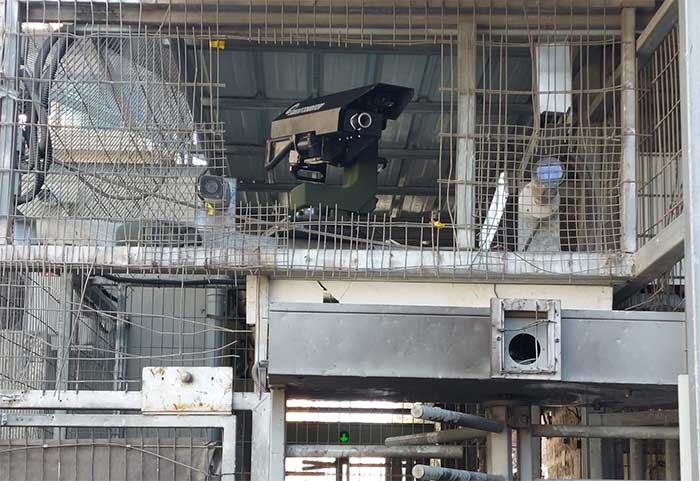
Automated gun turret similar to those at the Aroub camp in the city of Hebron, located just 10.6 km from the Aroub refugee camp. According to a report, the weapon systems at the Shuhada street checkpoint can fire stun grenades and tear gas, as well as rubber-tipped projectiles. (Photo: New Arab).
2. AI-guided Missiles
Guided missiles have been a weapon in the arsenals of modern militaries for decades. Early missile models used optics for tracking, followed by infrared and laser systems, but all of these factors required specific inputs to successfully reach their targets. The next generation of guided missiles will possess the ability to autonomously adjust their flight paths using algorithms designed to respond to changing battlefield conditions.
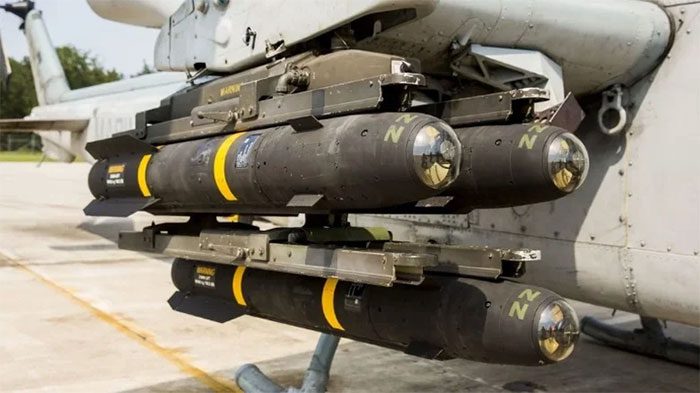
Developed by the U.S. Department of Defense (DOD), this next generation of guided missiles will be capable of independently tracking targets after launch using optical images, infrared, radar, and other technologies, employing AI to maintain target fixation and adjust its trajectory. These long-range weapons can strike targets up to 200 miles (321.8 km) away and achieve near-perfect accuracy. Furthermore, data links may allow various types of weapons to operate together, sharing information to update target information throughout their flight.
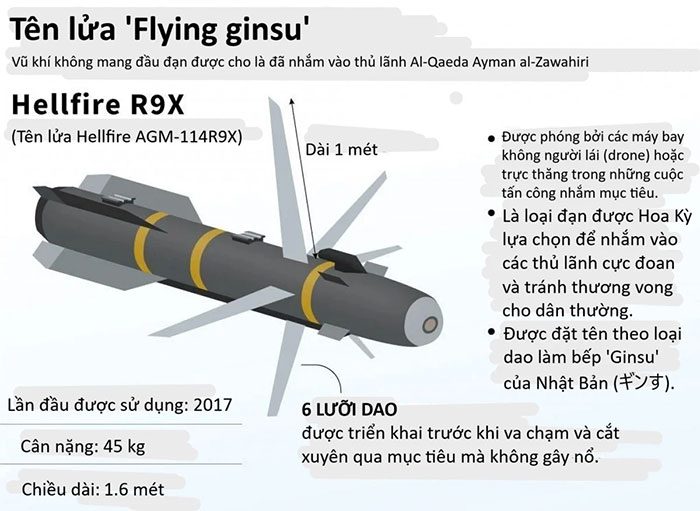
The Hellfire R9X missile is the closest example of an AI-guided missile, although it is actually guided by radar and GPS. The first stage of the guidance system uses GPS to locate the target, while the second stage uses a laser to guide the missile to its destination. This two-stage guidance system ensures that the Hellfire R9X can hit targets even when they are moving (for example, moving from one room to another or entering and exiting a building) or when there is interference. AI-guided missiles are expected to take over both stages with significantly greater accuracy and flexibility. (Photo: AP).
While more precise targeting may be seen as a way to ensure that attacks on strict military targets can reduce potential civilian casualties, this technology is developing at a rapid pace. There remains a reason to be cautious about this technology falling into the wrong hands.
3. Drone Swarms
Many of us have had the opportunity to experience the wonder of a drone light show, where swarms of drones fly around in the night sky gathering to create illuminated images above. This dazzling entertainment is made possible by drone and AI technology, but the underlying factors that make this light show feasible can also be applied to weapon systems to create devastating effects.
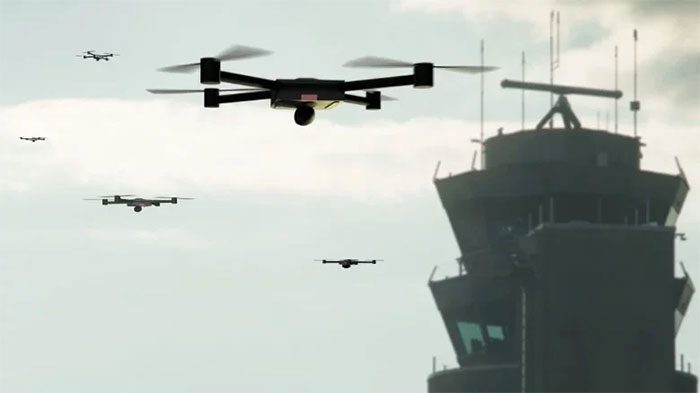
The Pentagon has named this initiative Autonomous Multi-Domain Adaptive Swarms-of-Swarms (AMASS). The goal is to develop the capability to launch a fleet of drones from land, sea, and air—all interconnected and automated—to surround enemies and dominate their strongholds with overwhelming force. The U.S. Department of Defense is actively working on this project, investing billions of dollars into research and development. Among other countries, it is known that China, in particular, is pouring billions into military AI research, creating a modern arms race based on advanced technology.
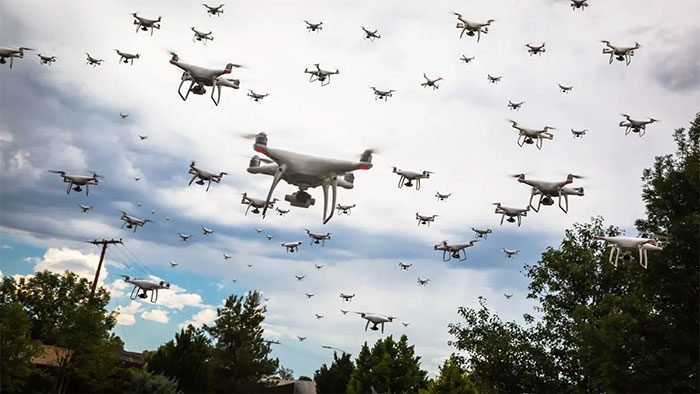
A fleet of drones used to detect military targets during AI testing by AUKUS (Australia – United Kingdom – United States). (Image: Naval Technology).
Israel has deployed a fleet of drones. In 2021, the Israel Defense Forces (IDF) sent a fully automated fleet of drones to locate and attack Hamas, along with other conventional weapons. While the U.S. Department of Defense has safeguards to maintain certain ethical principles related to AI, as this technology matures and spreads to other countries, those safeguards may become insufficient.
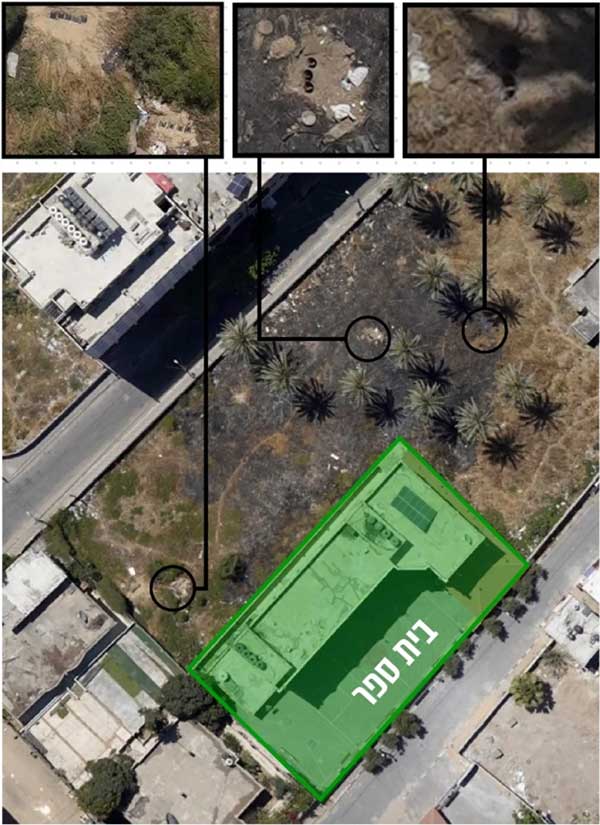
The result of drone technology: An image captured by an Israeli drone shows 14 underground rocket launchers located in the yard of a school in Gaza used by Palestinian terrorist groups during the May 2021 conflict between the Israel Defense Forces and Hamas. (Image: Times of Israel).
4. Robotic Soldiers
The idea of soldiers on the battlefield facing ruthless machines that act with precision, like the Cylon Centurions from Battlestar Galactica or the droid army from Star Wars, seems like flights of fancy from the world of science fiction, but reality may soon mirror that scenario. The U.S. Department of Defense is heavily investing in advanced weaponry using AI and other automation technologies to augment manpower for land, sea, and air forces.
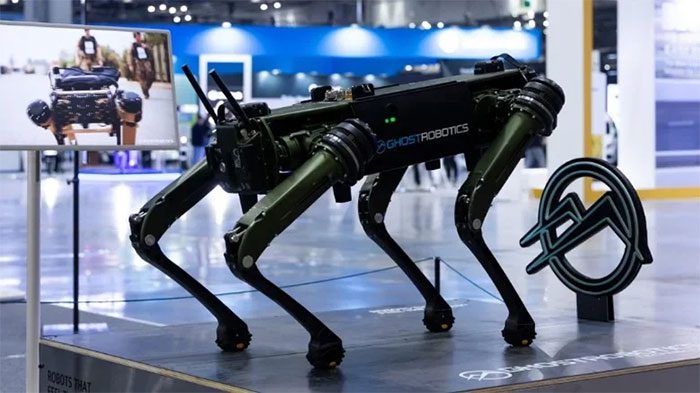
While practical machines may not resemble humanoid forms with two legs, their autonomous nature and full weaponry can manifest in wheeled or tracked forms, and even those with limbs. While Boston Dynamics has committed not to develop its robots for military purposes, other companies have not. Ghost Robotics is developing four-legged robotic dogs, with their legs enabling these machines to traverse most surfaces and stairs, reaching places where wheels or tracks might get stuck. They can be used as automated assistants, employing AI to monitor the activities of deployed units, following soldiers automatically via wireless connections. They can also be employed for reconnaissance, bomb disposal, or remote weapon firing, keeping soldiers out of enemy fire.
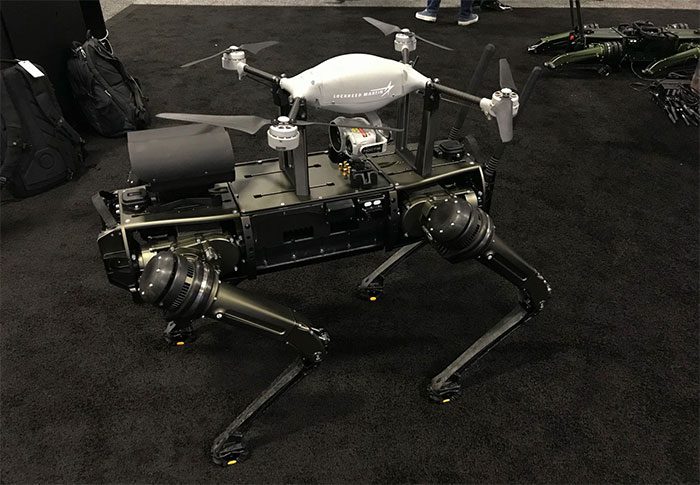
The Ghost Robotics robot dog carries Lockheed Martin’s Indago drone and reconnaissance sensors from Digital Force Technologies to enhance combat capabilities at a military exhibition in 2021. (Image: Twitter).
The potential applications of such devices are endless but also create a moral minefield. Establishing boundaries on how to deploy these technologies to achieve international agreements may make “ethical” demining more challenging than traditional methods. Nevertheless, don’t expect to see robots lining up against each other on the battlefield.
5. AI-Driven Intelligence Gathering
A good commanding officer knows they can only be effective with sufficient information to act upon. Throughout various periods, intelligence gathering has been a crucial part of any successful military campaign, and it has become exponentially more complex over the last three decades. Although we have been in the digital age for quite some time, the integration of AI into intelligence-gathering technologies is set to elevate that sophistication to levels unimaginable just a decade ago.
There will never be a substitute for visually tracking the enemy, but the digital world we all operate in offers pathways to collect various types of intelligence.
The U.S. Army Cyber Command, established in 2010, supports the military in numerous ways, including digital surveillance. When applied to military intelligence, AI enhances the speed of data collection and analysis exponentially. The Air Force wants it integrated into all its future intelligence technologies. Not only can it collect vast amounts of data, but it can also be trained to analyze specific information and process it into actionable intelligence automatically. It also breaks down language barriers and can be used for voice and facial recognition in ways that were previously unachievable. And this burgeoning field is just beginning its journey.

U.S. Marine Corps soldiers from the Cyber Command observe a computer screen at the cyber operations center in Fort Meade, Maryland, on February 5, 2020. (Image: Defense).
The relaxation of automated AI intelligence gathering in society poses a danger of a surveillance network targeting ordinary citizens. The risk of infringing constitutional rights is high as this technology develops, prompting many to urge the government to closely monitor the Department of Defense to prevent civil liberties from being compromised in the name of security.
6. Autonomous Drones
As part of Australia’s defense initiative, Boeing is developing and manufacturing what is called the MQ-28 Ghost Bat, which has drawn significant interest from the U.S. Air Force. This new aircraft is not only the latest in drone technology, but the integration of AI will differ greatly from existing platforms like the Predator. The Ghost Bat is a “loyal wingman” controlled by AI, tasked with flying alongside combat fighters and assisting pilots in missions by enhancing their existing surveillance and firepower capabilities.
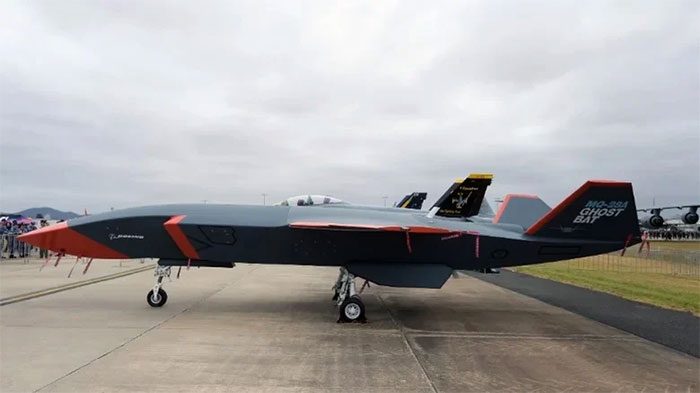
The Ghost Bat has a range of 2,300 miles with a continuous flight time of 16 hours and can reach near-supersonic speeds thanks to its Pratt & Whitney PW 600 turbofan engine. Unlike other drones operated from ground command centers, it will be controlled by a manned aircraft with several AI-operated systems to allow it to perform mission functions autonomously. It will have functions that allow it to tail the main aircraft (piloted) without requiring the pilot to provide specific flight control inputs, and also has the capability of automatic takeoff and landing.
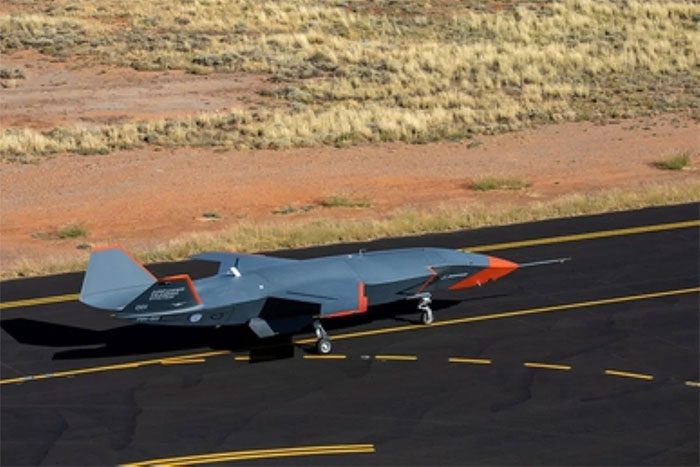
The Boeing MQ-28 Ghost Bat during a high-speed ground test. (Image: Wikipedia).
The Ghost Bat has yet to be deployed in any air force, but testing is underway and it could soon be certified. This technology does not present many ethical dilemmas or threats to civilians; however, for opposing forces, it will be a formidable enemy, exponentially multiplying the forthcoming threats with an aerial device that doesn’t fear casualties like conventional fighters.
7. Autonomous Submarines
Officially, unmanned submarines are referred to as Unmanned Underwater Vehicles (UUV), and the development of this type of vehicle is progressing smoothly. The United States Navy and other countries have deployed numerous UUVs that are remotely controlled from command stations on land or at sea. Ukraine has its own indigenous vessel and successfully conducted missions against the Russian naval forces during the Russia-Ukraine conflict in 2022. However, future deployments of UUVs will have enhanced autonomy thanks to AI integration in their navigation and targeting systems.

The U.S. Navy is making efforts to expand its UUV fleet, with an increasing number of AI-operated vessels. A particular area of interest is their deployment in the Caribbean Sea and around South America for missions to combat drug smuggling, as well as efforts to prevent human trafficking. AI can assist UUVs in detecting and tracking suspicious vessels while simultaneously alerting personnel on the surface in real time about the location of potential threats.

Operational diagram of U.S. Navy UUVs. (Image: Thanh Niên).
The Royal Navy has begun research and development on the largest UUV planned to date. It can operate up to 3,000 miles from its home port for a maximum duration of three months. The real crux of the story is that its navigation and actions will be entirely guided by AI, allowing it to operate completely silently when deployed. The issue lies in the protective measures applied to prevent a less-than-perfect AI from disrupting the surrounding waters.

Key components of autonomous submarines, as illustrated in a presentation on controlling AI-enhanced UUV propulsion: (a) Unmanned Underwater Vehicle Aries; (b) ECI-40 Maxon underwater drive motor and gearhead; and (c) underwater propulsion propeller. (Image: MDPI).
8. Robotic Insects
For centuries, scientists and engineers have looked to nature for inspiration in applying mechanical design concepts to create new technologies. The world of insects provides abundant inspiration for modern innovations, including miniature drones. These devices are perfect for conducting covert surveillance missions, as they can be designed small enough to move into enemy territory with near-total stealth. Moreover, when used en masse, it can be extremely difficult for adversaries to eliminate them.
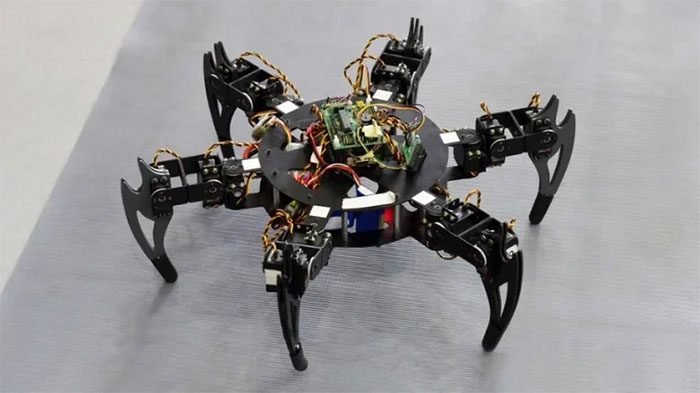
Insect-shaped military robots are on their way to becoming a reality. The British Special Forces have utilized WASP, a 6-inch-sized aircraft used for reconnaissance missions in Afghanistan. Although operated remotely, integrating AI is the next step in its development. Ongoing research in this area has sought to overcome several obstacles. The limitations in miniaturizing processors, storage, and continuous power supply for these devices are significant, but these challenges are not insurmountable with further research and testing.
The U.S. Department of Defense has awarded contracts through DARPA to develop small, insect-inspired robots, primarily for search and rescue missions or conducting inspections in environments hazardous to humans. However, as with many civilian technologies in the past, it may only be a matter of time before more tactical applications are developed, without any treaties or ethical guidelines to limit the destructive nature of these new micro weapon systems.
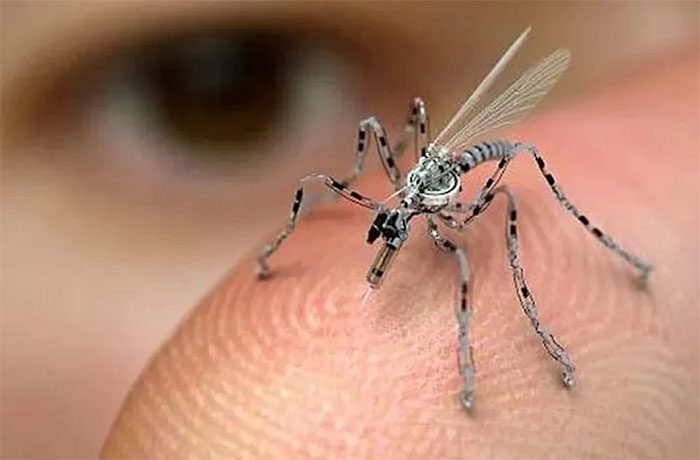
DARPA officials explain that research into insect-sized robots has benefitted from previous technological advances in microelectromechanical systems (MEMS), additive manufacturing, piezoelectric actuators, and low-power sensors. To date, there have been no ultra-small robots or complete systems capable of performing complex tasks proficiently. Currently, most ultra-small and small robots rely on physical, optical, magnetic, or RF (radio frequency) connections for power, control, and processing, which limits their utility. (Image: Military Aerospace).
9. Robotic Mules
Some of the more practical upcoming applications of AI and robotics involve machines that can assist soldiers in carrying equipment and supplies into combat. Modern soldiers carry approximately 27 pounds (about 12 kg) of personal protective gear before adding any weapons, ammunition, or rations. With all the gear, a soldier can carry loads of up to 140 pounds (63.5 kg)! This increases fatigue, reduces mobility, and raises the likelihood of injuries.

The heavy equipment of a modern soldier: U.S. Army Captain Kevin Wiley from the 5th Battalion, 20th Infantry Regiment, taking cover with a mat during a break in Operation Regular Flint in the village of Shele Kalay, Kandahar Province, Afghanistan, on January 16, 2012. However, they still must always carry all personal gear with them. (Image: Task and Purpose).
New and developing technology aimed at creating autonomous robotic mules is emerging to help soldiers fight more agilely and with less fatigue. To alleviate the burden on soldiers, DARPA has developed the Legged Squad Support System (LS3). It is a robotic mule designed to carry loads, developed since 2012. However, after extensive testing, it was determined that it would be too noisy for practical use. Today, there is the Multi-Utility Tactical Transport (MUTT), an 8-wheeled electric unmanned ground vehicle capable of carrying heavy supplies to places where conventional trucks cannot go. It can be operated remotely or semi-autonomously using GPS signals and an inertial navigation system. It also has a tracked version and can operate underwater.

The tracked version of the MUTT (4 × 4 version). In addition to its utility in transporting heavy equipment (right image) or even injured soldiers, the armed variant (left image) is equipped with Javelin anti-tank missiles, .50 caliber machine guns, and M4 rifles. Future capabilities will include automated resupply, counter-unmanned aerial systems (C-UAS); defense against chemical, biological, radiological, and nuclear (CBRN) threats; intelligence, surveillance, and reconnaissance (ISR); electronic warfare (EW); direct and indirect fire capabilities. (Image: Military Leak).
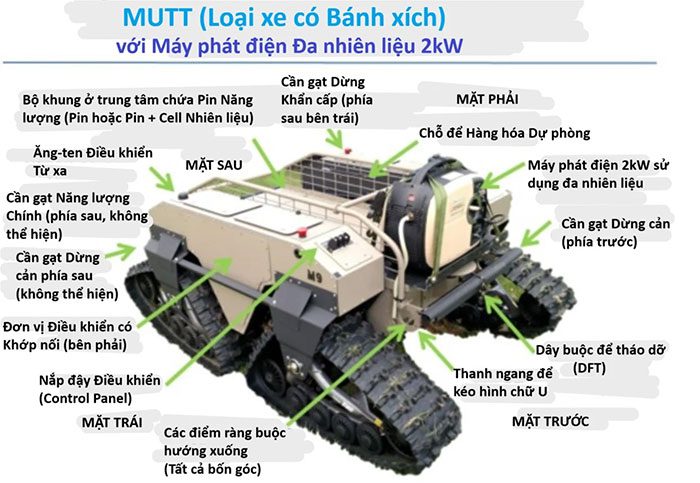
Structure of the tracked MUTT. (Image: Military Leak).
These are among the less intimidating aspects of the upcoming generation of AI-supported military technology. However, as they enhance tactical troops on the ground, they provide a distinct advantage over adversaries who must carry supplies on their backs.
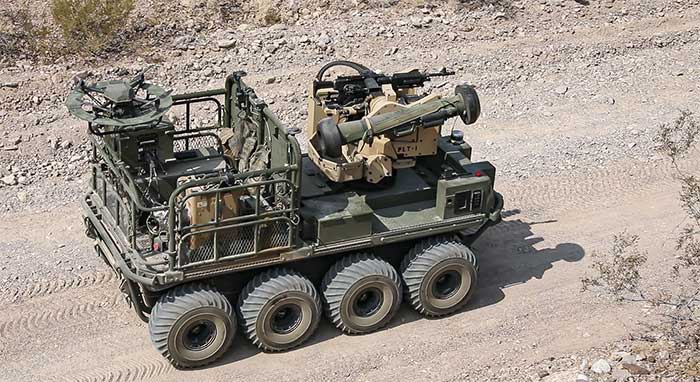
U.S. military forces receive General Dynamics’ MUTT in the 8 × 8 version. Its compact size of 2.9 meters x 1.5 meters allows it to navigate through tight terrain and be transported by helicopter. The vehicle’s payload of 1,136 kg enables it to carry water, ammunition, rations, spare batteries, and other supplies, allowing units to operate without immediate resupply. Onboard power generation will also supply energy for equipment and charge batteries. This enhances the operational endurance capabilities of forward units. (Image: Armada).
10. Underwater and Terrestrial Surveillance Robots
Another real-world scenario that mimics science fiction is the GuardBot. Similar to the BB-8 droid from Star Wars, GuardBot is an automated rolling ball that can provide covert surveillance both on land and underwater.

The GuardBot resembles a two-faced eyeball, stepping out of a movie about an alien invasion. While the Marine Corps is testing it as a highly functional “amphibious” reconnaissance vehicle, the original purpose of the GuardBot is even more science fiction-like: it was initially designed to traverse Mars. Photo: Popular Science.
This is considered an Unmanned Ground Vehicle (UGV) developed in collaboration between Aquiline Drone and Guardbot. The structure of the GuardBot is quite unusual but provides it with powerful capabilities: it is a rolling ball equipped with a camera that can offer 360-degree views while moving on land and underwater. It can come in various sizes, ranging from just 6.5 inches to 7 feet in diameter, with an internal mechanism that allows it to move forward and backward as well as having a free rotating range. Compartments on either side house interchangeable devices like video cameras, infrared sensors, thermal sensors, microphones, and audio equipment. It can operate for up to 25 hours on a single charge, moving at a speed of 12 miles per hour on land and 3 miles per hour underwater. Its unique shape enables it to overcome various obstacles and climb slopes. The single-point contact pads have low rolling friction, which helps reduce power consumption.

A GuardBot without contact spikes – the less common version, implying that its friction with the ground is substantial and more suitable for aquatic environments. It can be operated remotely using a 2-8 GHz data link and a laser spectrometer housed in a transparent dome, capable of detecting chemicals used to make bombs from a distance of just 2 inches. (Photo: IBTimes).
This unique device can also be programmed with AI to serve as a mobile “guard” in a geographically fenced area, providing users with the ability to monitor enemies from a distance with minimal detection risk. Testing with the U.S. Marine Corps began in 2014. Information regarding any official deployments is quite scarce, but the device remains present and may be assisting the military somewhere right now.
11. Ground-Moving Combat Vehicles
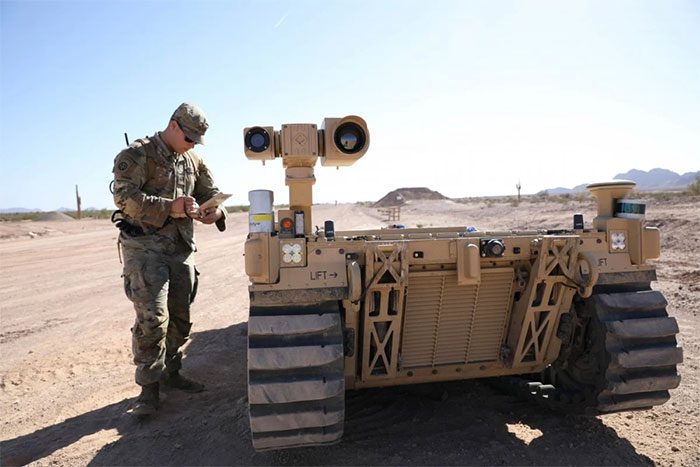
In 2021, the U.S. Army tested a fleet of Next Generation Combat Vehicles (NGCV) during Project Convergence 21 (PC21), which is a large-scale modernization trial and a foundational effort by the Army Futures Command. As part of the ongoing experimentation at Army facilities in Arizona and New Mexico, groups of soldiers, civilians, contractors, and industry experts are testing the latest advancements in modern warfare, including AI technology. (Photo: Army).
Starting in 2021, the U.S. Army has been testing the next generation of unmanned combat vehicles controlled by AI. The final announcement on which projects will be awarded contracts is still pending, and the scope of potential systems is currently very diverse. Some ideas being explored include small, agile tracked vehicles with heavy weaponry that can be remotely controlled or semi-autonomous, as well as larger assault vehicles that can be used with or without a human operator. AI can be applied not only to propulsion and navigation but also to targeting and monitoring systems that adapt to real-time conditions on the battlefield, while keeping soldiers at a safe distance.

The THeMIS UGV from Milrem Robotics on a mission in Mali, designed to withstand harsh environmental conditions and high temperatures. Additionally, the UGV is equipped with automated functions including point-to-point navigation and obstacle detection and avoidance, allowing it to keep pace with ground troops, patrol perimeters, supply front lines, and evacuate injured soldiers with minimal operator intervention. (Photo: Military Embedded).
As these projects eventually come to fruition, we can envision a scenario where battles occur between remotely controlled devices, with battalions on standby to seize territory or advance to the front lines with reduced risk. However, in any confrontation between unequally matched opponents, those possessing these advanced combat systems will hold a significant advantage. While this may reduce casualties in battle, it could also spark a new arms race based on technology and AI, with both good and bad intentions.




















































